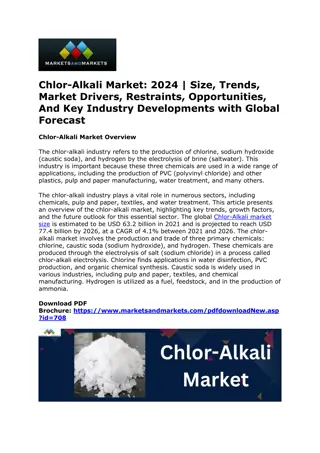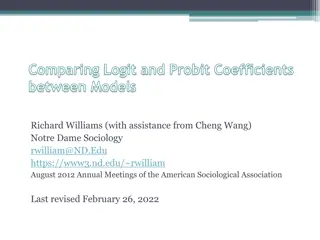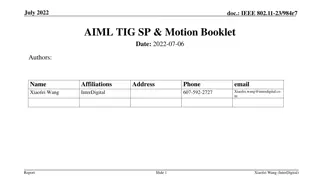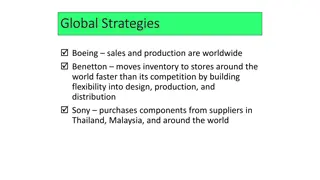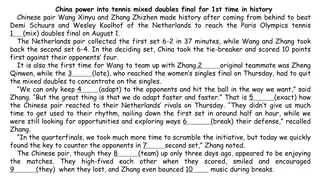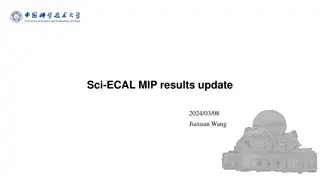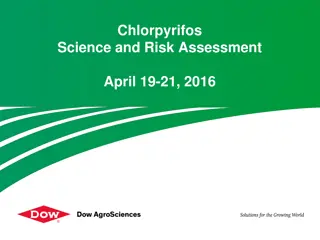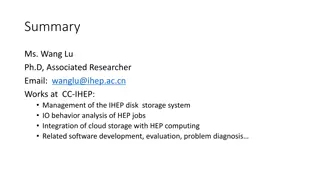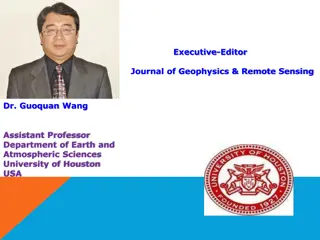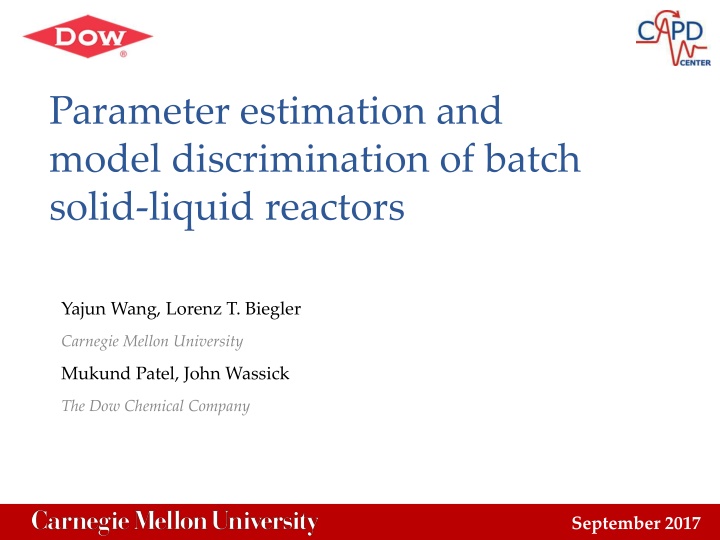
Parameter Estimation and Model Discrimination in Batch Solid-Liquid Reactors
Explore the challenges and approaches in parameter estimation and model discrimination of batch solid-liquid reactors. The study delves into reactor modeling, reaction mechanisms, and the significance of industrial case studies. Gain insights into sensitivity coefficient matrix and estimability evaluation for enhanced understanding and application in the field.
Download Presentation

Please find below an Image/Link to download the presentation.
The content on the website is provided AS IS for your information and personal use only. It may not be sold, licensed, or shared on other websites without obtaining consent from the author. If you encounter any issues during the download, it is possible that the publisher has removed the file from their server.
You are allowed to download the files provided on this website for personal or commercial use, subject to the condition that they are used lawfully. All files are the property of their respective owners.
The content on the website is provided AS IS for your information and personal use only. It may not be sold, licensed, or shared on other websites without obtaining consent from the author.
E N D
Presentation Transcript
Parameter estimation and model discrimination of batch solid-liquid reactors Yajun Wang, Lorenz T. Biegler Carnegie Mellon University Mukund Patel, John Wassick The Dow Chemical Company September 2017
Overview Problem statement & Motivation Reactor modeling Parameter estimation Industrial case study Conclusions & future work 2
Problem Statement & Motivation Agitator Batch reactor Solvent and reactant materials Vent Solvent Solid W Preparation Cooling water inlet Reactor jacket Solid-liquid Reaction Liquid X Cooling water outlet W(s) + X(l) Y(s/l) + Z(s) Reactor discharge Unknown reaction mechanism Surface reaction, dissolution, diffusion Different particle shapes and sizes Product effects Limited information Lack of concentration measurements An over-parameterized model without enough data 3 Reactor Modeling Parameter Estimation Industrial Case Study Significance & Potential Impact Problem Statement & Motivation
Reaction Mechanisms Shrinking particle model (SPM) s lc Dissolution model (DM) Assume dissolution is the rate limiting step. b lc Reactant Reactant Fluid film reactant reactant Solid particles dissolve into solvent Liquid liquid reaction Liquid reactant diffuses onto the particle surface Solid-liquid reaction Solid product breaks off from reaction surface. Products precipitate into solid phase. Reaction rate of SPM depends on liquid reactant concentration while DM doesn t. 4 Reactor Modeling Parameter Estimation Industrial Case Study Significance & Potential Impact Problem Statement & Motivation
Batch Reactor Model Total surface area is related to total amount and the shape of particles[1]. aM = 1/ s 1 1/ s a a s S N N 0 R 0 s E RT dN dt aM a = = 1/ s 1 1/ s a a s l (c ) s s SR N N k e SPM s s 0 0 s s R 0 s Parameters E RT dN dt aM a = = 1/ s 1 1/ s a a s s kS N N k e DM s s 0 0 s R 0 s Model indicator F=0 DM F>0 SPM [1] Salmi, Tapio, et al. "New modelling approach to liquid solid reaction kinetics: From ideal particles to real particles." Chemical Engineering Research and Design 91.10 (2013): 1876-1889. 5 Reactor Modeling Parameter Estimation Industrial Case Study Significance & Potential Impact Problem Statement & Motivation
Sensitivity coefficient matrix Parameter Estimation Estimability evaluation Estimable? NO YES EVM formulation Data reconciliation Parameter estimation Prior Bayesian estimation Reduce parameter set/ Simplify model Information Experiments Estimation quality analysis Estimation covariance matrix Confidence region Small Confidence interval? YES NO Posterior probability share Bayes theorem Fitting Number of parameters Posterior probability share Validation by unseen batch data Cross validation Model Validation 6 Reactor Modeling Parameter Estimation Industrial Case Study Significance & Potential Impact Problem Statement & Motivation
Industrial Case Study Agitator Solvent and reactant materials Solid-liquid batch reactor Vent Plant data: k batches k = 1 NS Reactor jacket Jacket temperatures Inlet flowrates Reactor weights Cooling water inlet Measured input ukj* Cooling water outlet Measured output ki* Reactor temperatures Laboratory data: 1 batch (extremely limited) Reactor discharge Measured input ukj* Weight of materials Measured output ki* Concentrations Normally distributed measurements 7 Reactor Modeling Parameter Estimation Industrial Case Study Significance & Potential Impact Problem Statement & Motivation
Step 1. Estimability Evaluation Sensitivity coefficient matrix QR transformation with column permutation[2] Rank parameters by their individual variance contribution Parameter rankings at different points are different All parameters are included in the estimation [2] Weijie Lin, Lorenz T. Biegler, and Annette M. Jacobson. Modeling and optimization of a seeded suspension polymerization process. Chemical Engineering Science, 65(15):4350 4362, 2010. 8 Reactor Modeling Parameter Estimation Industrial Case Study Significance & Potential Impact Problem Statement & Motivation
Step 2. Prior Information Laboratory experiments Isothermal reaction: no energy balance Limited data: only 1 batch of experimental data Possibly different reaction rate: better mixing Estimated A by experimental data is not reliable Shape factor E and reaction model indicator F can be determined Will be used as prior for plant estimation 25 20 Weight fraction % 15 Predicted solid reactant W Predicted liquid product Y Data solid reactant W Data liquid product Y 10 Dissolution reaction 5 0 0 0.2 0.4 Scaled time 0.6 0.8 1 9 Reactor Modeling Parameter Estimation Industrial Case Study Significance & Potential Impact Problem Statement & Motivation
Step 3. Bayesian Estimation Reactor temperatures Jacket temperatures Weights and flowrates EVM formulation Plant data Measured output errors Prior Information Measured input errors Reactor temperature 0.9 Predict Data 0.8 Scaled temperature 0.7 Full Model 0.6 0.5 0.4 WLS 0.3 0 0.2 0.4 Scaled time 0.6 0.8 1 Reactor temperature EVM does parameter estimation and data reconciliation simultaneously Better output data fitting Accumulated squared errors of EVM is reduced by 21% compared with WLS Intensive computational load EVM has 10748 variables and 9870 equality constraints Modeled in AMPL, solved w/ IPOPT (CPU time: WLS ~ 0.102 sec/iter , EVM ~ 0.111 sec/iter) 0.9 Predict Data 0.8 0.7 Scaled temperature 0.6 0.5 EVM 0.4 0.3 0 0.2 0.4 0.6 0.8 1 Scaled time 10 Reactor Modeling Parameter Estimation Industrial Case Study Significance & Potential Impact Problem Statement & Motivation
Step 4. Estimation Quality Analysis Estimated parameter values and variances Set Cb,X = Cs,X Fix parameter UA Heat transfer coeff. (U) depends linearly on temperature Candidate Models 11 Reactor Modeling Parameter Estimation Industrial Case Study Significance & Potential Impact Problem Statement & Motivation
Step 5. Posterior Probability Share Posterior probability[3] Jacket temperature Reactor temperature 0.9 Predict Data Predict Data 1 0.8 Scaled temperature Scaled temperature 0.8 0.7 Data fitting Model 4 0.6 0.6 0.4 0.5 0.2 0.4 0 0 100 200 300 400 Scaled time 500 600 700 800 900 0.3 0 100 200 300 400 Scaled time 500 600 700 800 900 [3] WE Stewart, Y Shon, and GEP Box. Discrimination and goodness of fit of multiresponse mechanistic models. AIChE journal, 44(6):1404 1412, 1998. 12 Reactor Modeling Parameter Estimation Industrial Case Study Significance & Potential Impact Problem Statement & Motivation
Step 6. Model Validation Reactor temperature Reactor temperature Validation by unseen data 0.9 0.9 Predict Data Predict Data 0.8 0.8 Use a new batch of data to evaluate predictability of the estimated model Scaled temperature 0.7 0.7 Scaled temperature 0.6 0.6 0.5 0.5 0.4 0.4 Training data Unseen data Cross validation 9-fold cross validation a) Randomly split measured output data to 9 sets b) Estimate parameters by 8 sets of data and use the left dataset to do model validation c) Repeat step b) 9 times, each dataset is used once in model validation and 8 times in estimation 0.3 0.3 0 0.2 0.4 0.6 0.8 1 0 0.2 0.4 Scaled time 0.6 0.8 1 Scaled time 0.025 Estimated value in each iteration Average of 9 estimations Estimated value by all data Estimated value in each iteration Average of 9 estimations Estimated value by all data 0.49 0.0245 0.488 3 0.486 0.024 Parameter UB Parameter A 0.484 0.482 0.0235 0.48 0.023 3 0.478 0.476 0.0225 0.474 0.472 0.022 1 2 3 4 5 6 7 8 9 1 2 3 4 5 6 7 8 9 Iteration Iteration 13 Reactor Modeling Parameter Estimation Industrial Case Study Significance & Potential Impact Problem Statement & Motivation
Conclusions & Future work Discussed two potential models for a solid-liquid reaction in a batch reactor Built a uniform dynamic model with an indicating parameter to discriminate two mechanisms Introduced a parameter estimation procedure based on Bayes Theorem Applied parameter estimations to the solid-liquid batch reactor model Conducted model validation to examine the model capability of predicting system behaviors Optimal control will be conducted based on estimated model to reduce the batch time 14 Reactor Modeling Parameter Estimation Industrial Case Study Conclusions & Significance Problem Statement & Motivation

